We use cookies to make your experience better. To comply with the new e-Privacy directive, we need to ask for your consent to set the cookies. Learn more.
The top 10 teas from China
Nowhere else in the world are so many tea varieties grown as in China. Something comparable to the tea cultivation in China is perhaps only the cultivation of wine. Just as every chateau in France cultivates its own wine label, every region in China cultivates its own
tea name.
In order to give tea drinkers some orientation when buying tea, tea competitions are regularly held in China. Over time, a list of tea varieties has emerged, which very often were among the winners of the competitions.
Unofficially there is therefore a "list of the 10 best tea varieties in China". The fact that exactly these 10 tea varieties are considered to be the best teas in China is determined by many factors.
Firstly, the cultivation of tea in the regions where these teas originate is favoured by very good natural conditions: Moderate temperatures, optimum ratios between sunshine duration and rainfall, nutrient-rich and slightly acidic soils - all in all, the best growing conditions for the tea plants.
On the other hand, the tea plants in these regions are optimised for the production of high quality tea through centuries of breeding. Last but not least, the intensive cultivation of tradition and experience also contributes to the high quality of these teas.
But what you have to bear in mind with this list is that a name on the Top 10 list is far from being synonymous with the best tea enjoyment.
There are very different quality levels even for a tea from this Top 10 list. The best teas are always made from spring plucking.
Although they fetch a very high price, tea farmers cannot make a living from them due to the small quantity.
Therefore, the top growing regions also produce teas of inferior quality for the broad market.
On the one hand, older leaves are plucked, on the other hand, teas are also picked in summer and autumn. As an example you can find
a comparison
between Lung Ching teas of different qualities in the chapter "Preparation".
 In the following the 10 best teas from China are presented individually, if possible with a picture of the tea.
An exact description of the taste and smell of the teas is not given, because this is very difficult and is perceived differently by different people.
Furthermore, the Chinese often use such a flowery language to describe the teas that a translation into German will not help the German tea drinker much.
In the following the 10 best teas from China are presented individually, if possible with a picture of the tea.
An exact description of the taste and smell of the teas is not given, because this is very difficult and is perceived differently by different people.
Furthermore, the Chinese often use such a flowery language to describe the teas that a translation into German will not help the German tea drinker much.
For the individual tea varieties, the names commonly used in Germany are used, if available.
The official Chinese Pinyin transcription is in brackets.
Green Tea
1. Lung Ching (Long Jing) - You can order this tea -
Lung Ching is undisputedly considered the best green tea in China. The original Lung Ching is only grown in the city of Hangzhou. Long Jing, as the tea is called in China, is actually the name of a small village near Hangzhou, situated on a hill southwest of the city centre.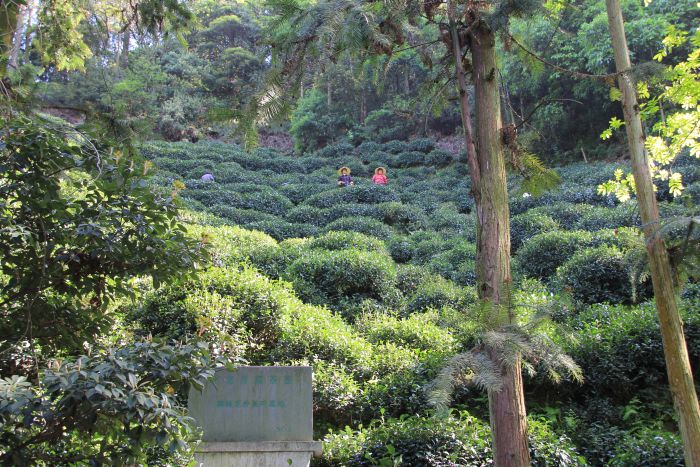 On Tiger Mountain, a small hill southwest of Hangzhou. Here the original Long Jing grows.
On Tiger Mountain, a small hill southwest of Hangzhou. Here the original Long Jing grows.
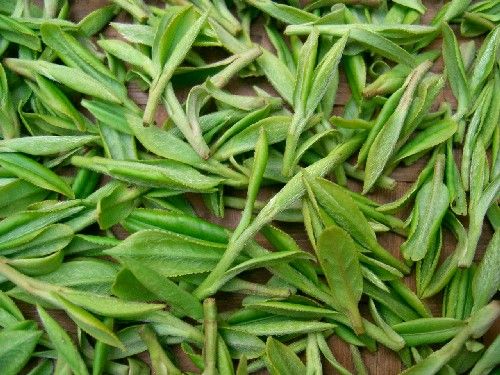
Long Jing
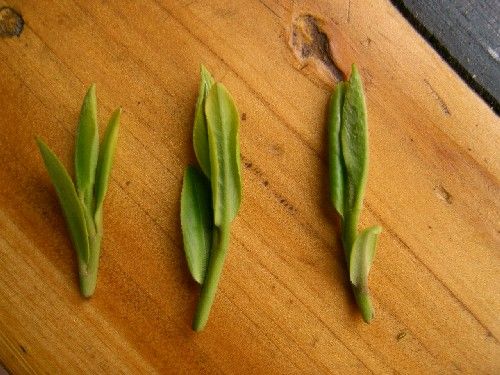
Freshly picked buds
The Lung Ching tea is a roasted green tea, i.e. the deactivation of the enzymes in the tea leaves is achieved by roasting:
after pre-drying at room temperature, the plucked material is roasted by hand for 12 - 15 minutes in a cast-iron pan, which is lightly greased and heated to 80 - 100°C,
and shaped by gentle pressing. In between, the leaves are cooled for 40 - 60 min. In a second roasting step, they are roasted for 20 - 25 min at 60 - 70°C and shaped by pressing them harder.
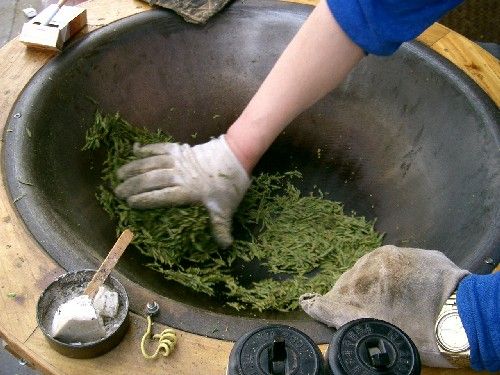
Roasting (traditionally in a pan)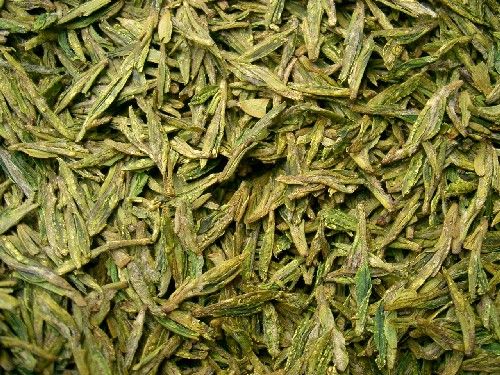
Ready roasted
Typically the Lung Ching tea has a very flat and compact appearance and a light green to yellow-green colour.
The yellow-green colour, which results from the low content of leaf green in the buds and young leaves, is typical for a high quality Lung Ching tea. However,
this yellowish discolouration should not be confused with
the yellowish discolouration of teas that have been stored too long
, where the green colour has been lost due to the decomposition of the leaf green.

Roasting (traditionally in a pan)

Ready roasted
The Lung Ching tea is characterised by its high amino acid and low catechin content, which means that it hardly tastes bitter
(of course, you should not let a Lung Ching steep too long).
The aroma of a high-quality Lung Ching is reminiscent of roasted chestnuts and is unmistakably intense.
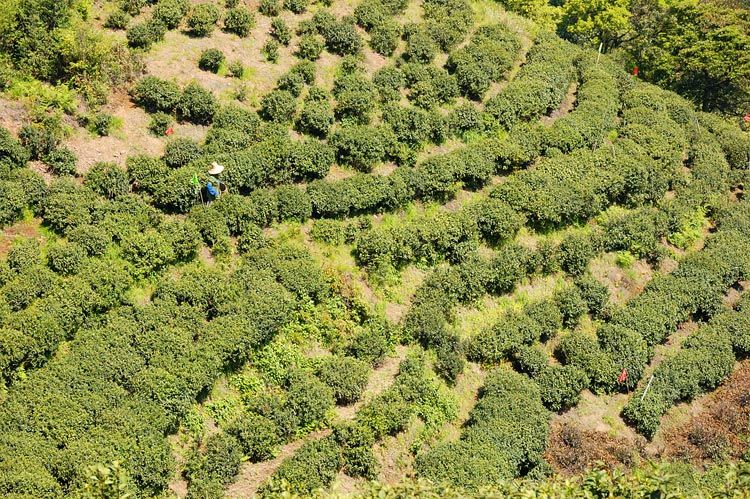
Tea plantation at the Lion Peak In recent years, the cultivation of Lung Jing tea has been extended to surrounding towns and counties. In order to avoid confusion between the original and the other Lung Ching varieties, the real one is called "Xihu-Long Jing" (West Lake Lung Ching) - you can order this tea - and the Lung Ching from the surrounding towns is called "Zhejiang-Long Jing" (Lung Ching from Zhejiang province). The very best Lung Ching is made from the tea bushes that grow on top of the Lion's Peak, a small hill not far from the village of Long Jing. This Lung Ching is called "Shi Feng Long Jing" (Lion Peak Lung Jing).
2. Pi Lo Chun (Bi Luo Chun) - You can order this tea -
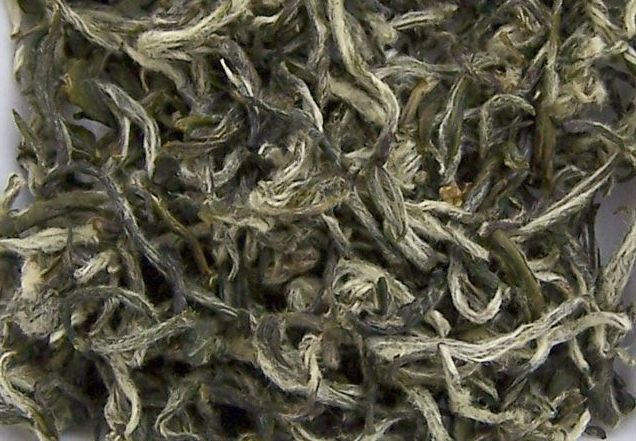
Bi Lo Chun The Pi Lo Chun from mainland China is not to be confused with the Pi Lo Chun from Taiwan, the latter, however, can be found much more often in German tea shops.
The original Pi Lo Chun comes from the city of Suzhou. It is cultivated on two small hills south of the city. One is located on a small island in Tai Lake (Tai Hu, the Great Lake), the other on a peninsula that juts into the lake.
Legend has it that the name of this green tea originated from the Qing Emperor Qianlong (reign: 1736 - 1796). On his journey to the south (the city of Beijing, located
 Peking
Peking
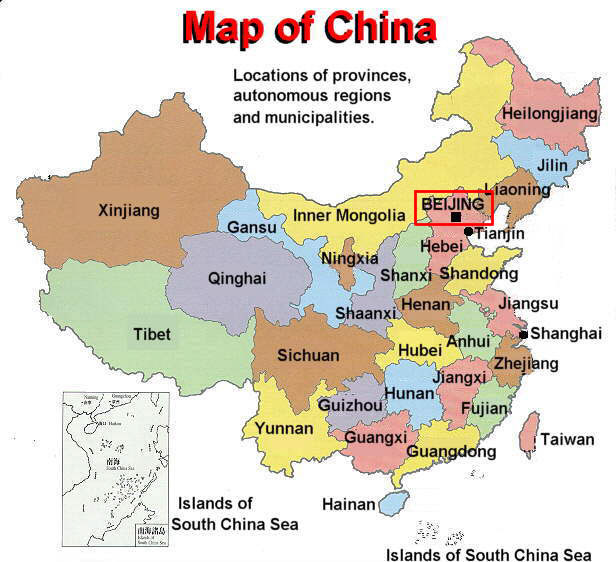
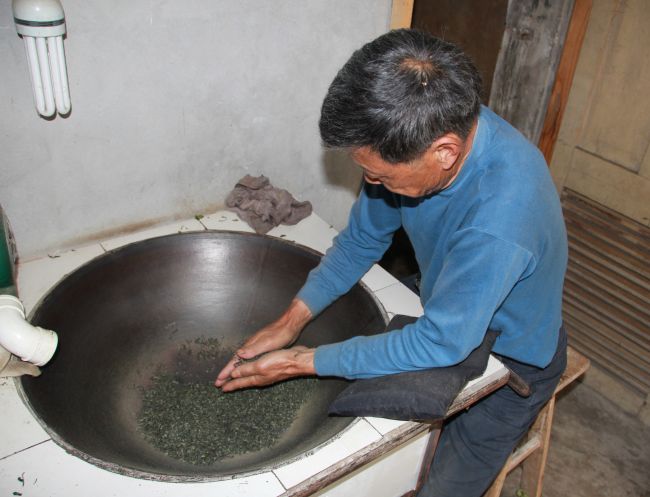 The original Pi Lo Chun is rolled by hand in a fired pan at 50-60°C.
The original Pi Lo Chun is rolled by hand in a fired pan at 50-60°C.
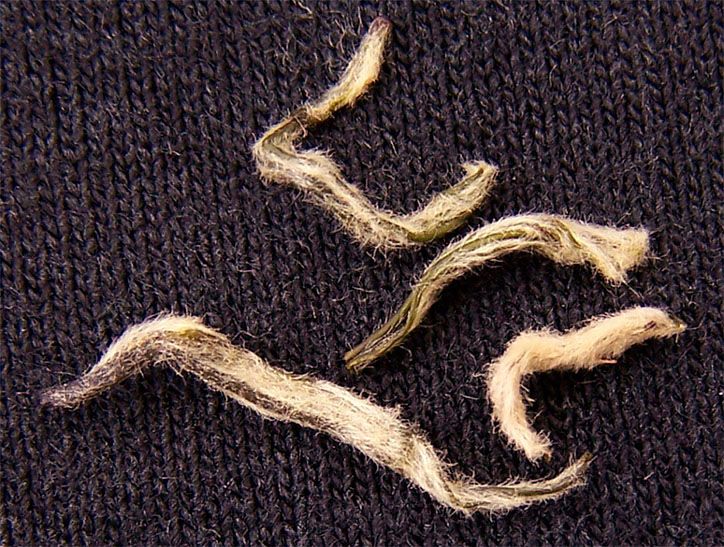 Pi Lo Chun from Suzhou. The surface of the tea leaves are covered with very fine, yellowish hairs. Only when you look closely can you see the green colour of the leaves.
Pi Lo Chun from Suzhou. The surface of the tea leaves are covered with very fine, yellowish hairs. Only when you look closely can you see the green colour of the leaves.
3. Huang Shan Mao Feng
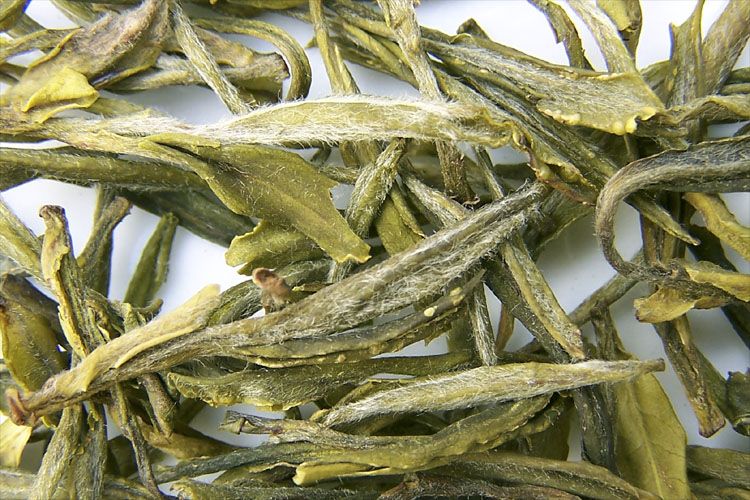
Huang Shan Mao Feng (Hairy Tip)
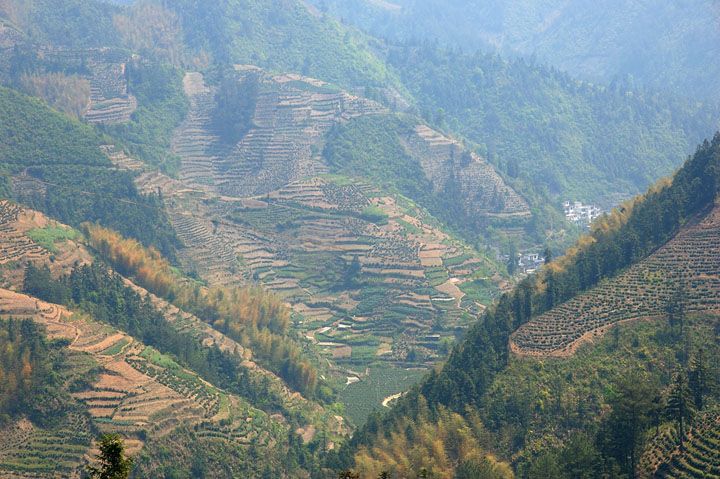
Tea plantations in the Huangshan Mao Feng production area
The Huang Shan Mao Feng has a rather short tradition. In the Huang Shan region (today: Huang Shan County) green teas have been cultivated and produced for export to Europe since the 18th century. In 1875, a tea merchant had fine buds of tea plants plucked at higher altitudes and had a new roasted tea made, which he called "Mao Feng" (hairy tips), because the tea has fine hairs and is shaped like a spearhead. When he offered this tea to English tea traders in his tea shop in Shanghai, they were very enthusiastic about the quality of this new tea. Mao Feng quickly became famous among tea lovers. Today the "Huang Shan Mao Feng" is one of the most famous green teas in China. The plantations for Mao Feng are spread over large areas in the Huang Shan region. For the best Mao Feng only tea plants are used, which grow in the Yellow Mountain National Park at an altitude of about 700 - 800 meters.
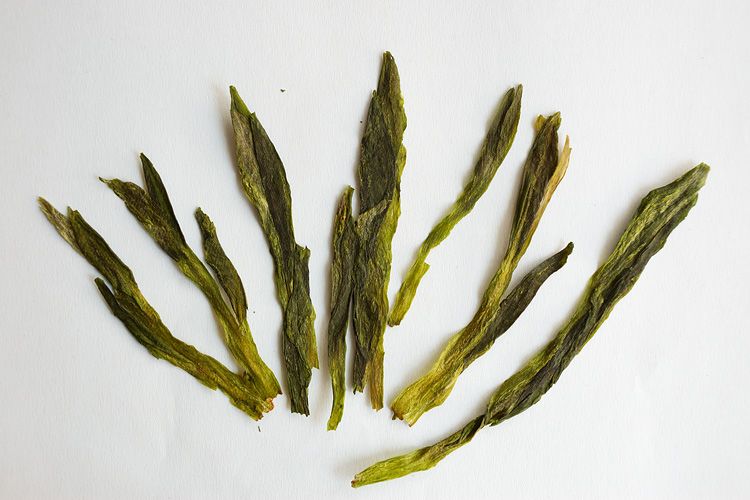
Tai Ping Hou Kui Personally, I find another green tea from the same region very convincing besides Mao Feng: Tai Ping Hou Kui. The name is composed of "Tai Ping", the place where the tea originally came from (a community in Huang Shan County), and "Hou Kui", which means monkey king. However, the tea has little to do with monkeys. "Hou Kui" is made up of the name of a village (Houkeng) and the name of a tea farmer, Wang Kuicheng, who invented the method of making tea. Since the tea is made from relatively large leaves, it is very difficult to keep the leaves intact during the production process. Therefore Tai Ping Hou Kui with large, intact leaves is very expensive. The special manufacturing process gives the tea an intense, almost citrus-like fragrance. The infusion is full-bodied, but still tastes mild, with hardly any bitter notes. - You can order this tea -
4. Liu An Gua Pian
In the northern foothills of the great Dabie mountain massif (in the north of Anhui
Anhui
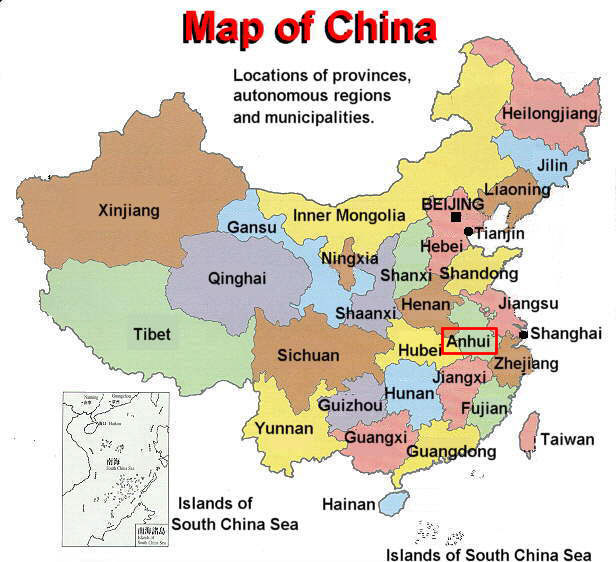
Oolong tea
5. Wuyi Rock Tea (Wuyi Yan Cha) - You can order this tea -
The region of the Wuyi Mountains has a very long tradition of tea cultivation. Jianzhou (the name of the region at that time) was already mentioned by Lu Yu in his book (8th century). Although the great master did not make a detailed assessment of the region, he made a casual comment that one was surprised from time to time by the very good quality of tea from the region.
It was not until the Song Dynasty (10th - 13th centuries) that it became more widely known.
The tea there was chosen as one of the tribute teas for the imperial court. The beautiful landscape of the Wuyi Mountains also contributed to the fame of tea from this region:
when the Song Emperor's Court had to move its capital to Hangzhou (only 450 kilometres away), the Wuyi Mountains became a popular meeting place for intellectuals who were all too happy to be inspired by nature over a cup of tea.
The region also became famous for the porcelain bowls fired here with a black glaze. These bowls were much sought-after in the Song period because of the tea fights.
In 1302, the Mongolian imperial court (Mongolian rule in China: 1271 - 1368, also known as the Yuan Dynasty) had an imperial tea plantation established in the area of
today's national park, which outlasted Mongolian rule by almost 200 years.
When tea exports to Europe later began, the Wuyi Mountains were one of the main tea growing regions for export. Bohea tea (Wuyi is pronounced like Bo-i in the local dialect) was long synonymous with tea from China.
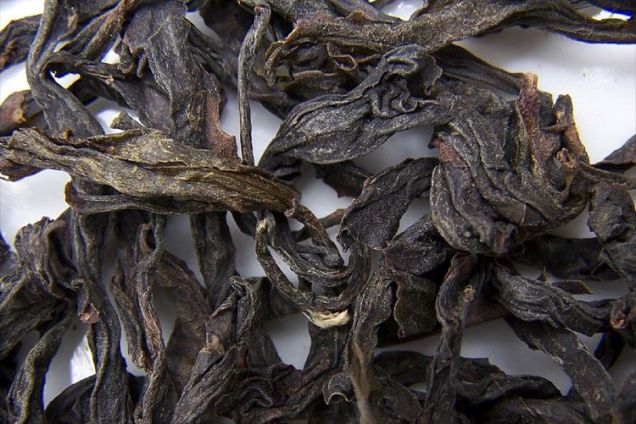 Wuyi Rock Tea. Due to the strong fermentation the stone tea looks almost like a black tea.
Wuyi Rock Tea. Due to the strong fermentation the stone tea looks almost like a black tea.
The region of the Wuyi Mountains is considered the place of origin of the Oolong. The region is also known for this today.
As the region is dominated by many rocks, the farmers had to use almost every crevice in the rocks to grow tea plants.
This special cultivation method led to the name rock tea. Strictly speaking, only the tea plants in the area of today's national park are allowed to bear the name rock tea.
Some individual tea bushes here are very famous. The most famous tea bush is the "Da Hong Pao" (Big Red Robe).
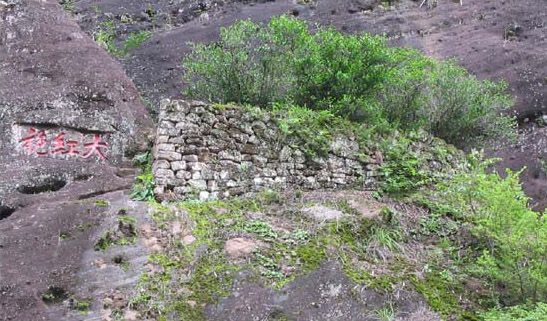 One of the few original examples of the Dao Hong Pao (Big Red Robe). At the left side of the rock the name of the plant is engraved.
One of the few original examples of the Dao Hong Pao (Big Red Robe). At the left side of the rock the name of the plant is engraved.
As for most Oolongs, the picking for the rock tea starts from April 24th.
The first 3 - 4 leaves of the new shoots are picked.
In contrast to green tea, the high content of catechins in the older leaves is not detrimental to the quality of an oolong, because the catechins lose most of their bitter taste through fermentation.
The Wuyi rock tea is a very strongly fermented oolong. Its appearance and taste is very similar to black tea.
6. Ti Kuan Yin - You can order this tea -
Ti Kuan Yin is grown in the town of Anxi in South Fujian
South Fujian
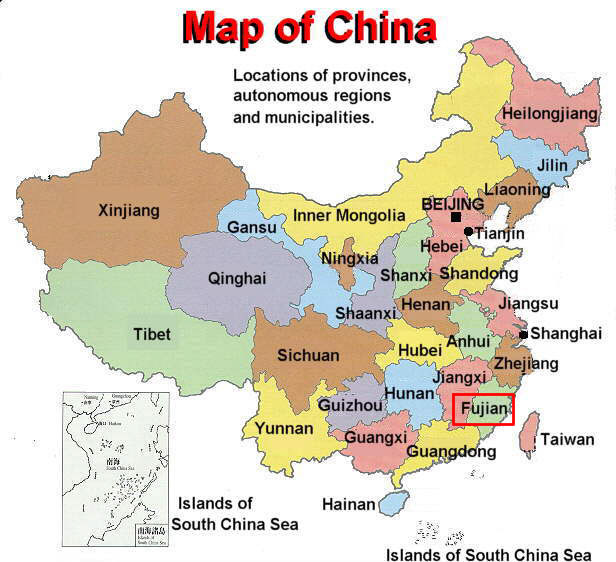
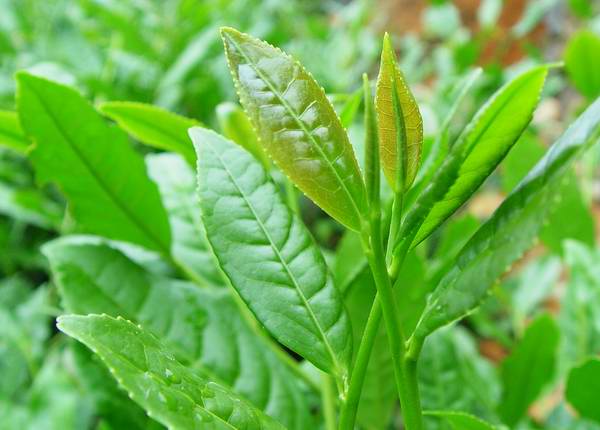 Red Heart Ti Kuan Yin. The faint red discolouration is clearly visible on the youngest leaves.
Red Heart Ti Kuan Yin. The faint red discolouration is clearly visible on the youngest leaves.
The real Ti Kuan Yin plant is also called "red heart" Ti Kuan Yin (Red Heart Ti Kuan Yin) because the young leaves have a faint red discolouration.
From the few original specimens, large plantations have now been established by vegetative propagation. The annual production of "Ti Kuan Yin" from the original plants is very low.
The price is accordingly high, at tea auctions they achieve astronomical prices. The production of "Ti Kuan Yin" in the plantations is largely mechanised.
The quality is comparable to the "Ti Kuan Yin" from the original plants.
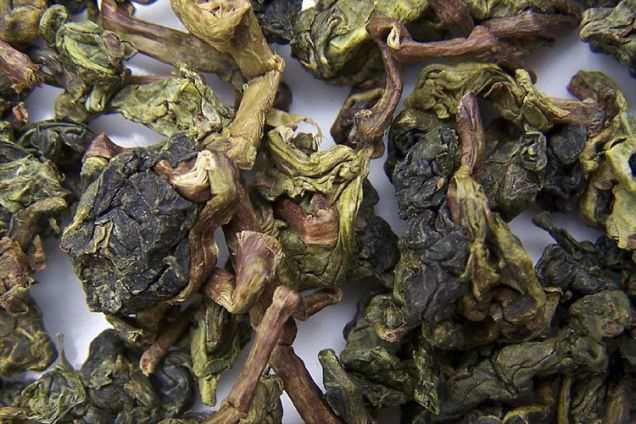 Anxi Ti Kuan Yin. A rather weakly fermented Oolong, recognizable by its mixture of red and green colours.
Anxi Ti Kuan Yin. A rather weakly fermented Oolong, recognizable by its mixture of red and green colours.
Picking begins at the end of April. Until the beginning of May, the pickings are considered spring pickings, from which the best Ti Kuan Yin is made.
The autumn pickings between the end of September and the beginning of October are also considered good: the autumn tea is very fragrant, but its taste is not as intense as the spring tea.
In contrast to the Wuyi rock tea, Ti Kuan Yin is a rather weakly fermented Oolong. The colour of the tea leaves is predominantly green, with a slight red colouring.
Good Ti Kuan Yin is expensive to produce. During production the leaves are treated by various mechanical printing and rolling processes. The strength of the leaves plays a decisive role in the quality of the tea. The stronger the leaves, the more likely they are to remain intact during processing. In the last production step, the bulbous rolled leaves are separated from the stems. If the quality is good, this is of course done by hand. Top quality can only be achieved in a limited time during the first growing period by selective selection of the leaves during plucking, which naturally has an effect on the production prices.
In addition to the processing and quality of the leaves, the quality of the soil plays an important role for the tea. Ti Kuan Yin is cultivated in large areas of Fujian. The quality of the soil there varies greatly. Coming from the east (near the coast), one finds light-coloured soil mixed with quartz gravel. Towards the west, the soil increasingly changes to a red, highly loamy soil. A high proportion of quartz gravel results in a strong smelling Ti Kuan Yin, which is weak in taste, however. The situation is different with clayey soil. Here you get Ti Kuan Yin, which has a good taste but remains weak in its smell. The best Ti Kuan Yin is obtained where the soil contains a balanced proportion of clay and quartz gravel. This geological condition is mainly found around the city of Anxi. Unfortunately, Ti Kuan Yin is almost obligatory offered abroad with the origin "Anxi", although it is often only Fujian teas. What here belongs to the area around Anxi is for many a very elastic term. One should therefore always compare the quality.
Almost half of the production price of good quality teas can be attributed to the separation of leaves and stems alone. Especially for the export markets, the separation of the stems is usually only done by machine. This usually leaves a large proportion of twigs and wood shavings in the tea with the well-known negative effects on the taste. Below is a comparison of the most important factors influencing the quality of a Ti Kuan Yin:
Each of these factors can influence the producer price by up to 50 percent. The harvest time also plays an important role. Ti Kuan Yin from the spring or autumn harvest gives the best taste.
Good Ti Kuan Yin is expensive to produce. During production the leaves are treated by various mechanical printing and rolling processes. The strength of the leaves plays a decisive role in the quality of the tea. The stronger the leaves, the more likely they are to remain intact during processing. In the last production step, the bulbous rolled leaves are separated from the stems. If the quality is good, this is of course done by hand. Top quality can only be achieved in a limited time during the first growing period by selective selection of the leaves during plucking, which naturally has an effect on the production prices.
In addition to the processing and quality of the leaves, the quality of the soil plays an important role for the tea. Ti Kuan Yin is cultivated in large areas of Fujian. The quality of the soil there varies greatly. Coming from the east (near the coast), one finds light-coloured soil mixed with quartz gravel. Towards the west, the soil increasingly changes to a red, highly loamy soil. A high proportion of quartz gravel results in a strong smelling Ti Kuan Yin, which is weak in taste, however. The situation is different with clayey soil. Here you get Ti Kuan Yin, which has a good taste but remains weak in its smell. The best Ti Kuan Yin is obtained where the soil contains a balanced proportion of clay and quartz gravel. This geological condition is mainly found around the city of Anxi. Unfortunately, Ti Kuan Yin is almost obligatory offered abroad with the origin "Anxi", although it is often only Fujian teas. What here belongs to the area around Anxi is for many a very elastic term. One should therefore always compare the quality.
Almost half of the production price of good quality teas can be attributed to the separation of leaves and stems alone. Especially for the export markets, the separation of the stems is usually only done by machine. This usually leaves a large proportion of twigs and wood shavings in the tea with the well-known negative effects on the taste. Below is a comparison of the most important factors influencing the quality of a Ti Kuan Yin:
| Origin: all of Fujian | ↔ | Anxi |
| Cultivation method: Conventional with pesticide usez | ↔ | Highlands without pesticide use |
| Harvesting method: by machine | ↔ | Handpflückung |
| Separation of the leaf tubers from the stem: by machine | ↔ | by hand |
| Harvest time: summer | ↔ | Spring/Autumn |
Each of these factors can influence the producer price by up to 50 percent. The harvest time also plays an important role. Ti Kuan Yin from the spring or autumn harvest gives the best taste.
7. Dong Ding-Oolong
 Taiwan
Taiwan
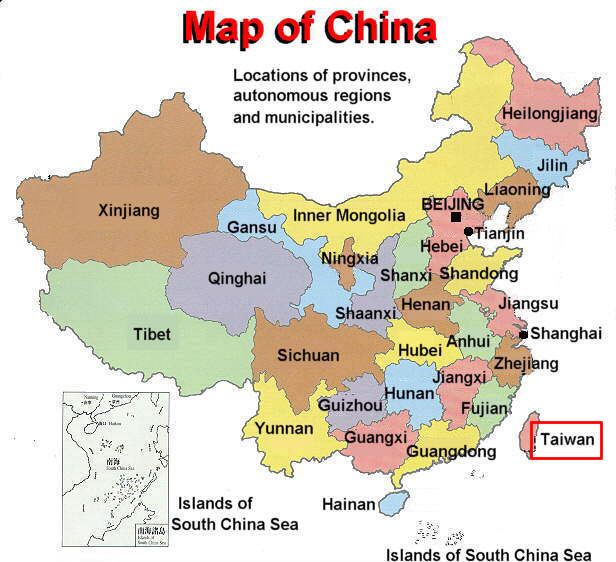
As the name suggests, the actual Dong Ding-Oolong comes from the Dong Ding mountain in the district of Nantou, which is almost exactly in the centre of the island. Originally, the tea plants for Dong Ding-Oolong were cultivated on the top of the mountain in a plantation not larger than 40 hectares. The plants were brought back to the island in 1855 by a certain Taiwanese man named Lin, who had to take the civil service examination in Fujian. With these plants, more precisely with 36 plants from Fujian, the complete tea cultivation on Taiwan was established. The production process was also adopted from the Wuyi Mountains (see rock tea) in Fujian. The cultivation of Dong Ding-Oolong today covers an area of about 1600 hectares. Because of the popularity of Dong Ding-Oolongs, many tea farmers in neighbouring districts also call their oolongs Dong Ding. It is therefore not so easy to get a real Dong Ding-Oolong.
Actually the Dong Ding-Oolong was a very strongly fermented oolong. Because the tea traders did not come to buy every year due to the difficult accessibility of this mountainous region, the farmers had to ferment the tea more to ensure that the tea had a longer shelf life. Some older tea drinkers still tell us today that the Dong Ding-Oolong could be stored for decades without any loss of quality! It is only in the last 20 years that the Dong Ding-Oolong has become less and less fermented. The reason was the changed preference of tea drinkers: More and more Taiwanese tea drinkers preferred weaker fermented Oolongs, because the tea aroma can develop better with weaker fermentation. Today the Dong Ding-Oolong is one of the least fermented oolongs. But not every oolong lover is happy about this development.
White Tea
8. Bai Hao Yin Zhen - You can order this tea -
Bai Hao Yin Zhen (White Hairy Silver Needle) was the first white tea to be produced in China. Yin Zhen is grown and produced in the Fuding and Zhenghe districts of Fujian
Fujian

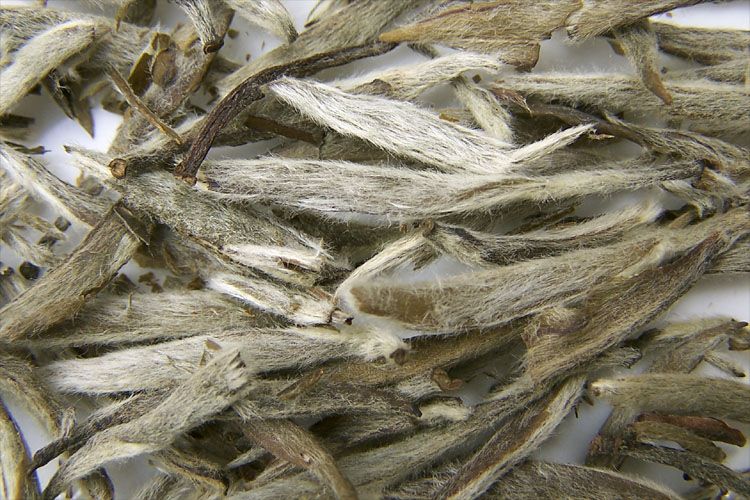 Bai Hao Yin Zhen (White hair silver needles). The name "White tea" comes from the thick white fluff on the back of the leaf buds.
Bai Hao Yin Zhen (White hair silver needles). The name "White tea" comes from the thick white fluff on the back of the leaf buds.
For high quality Yin Zhen, traditionally only the buds from the first two growth rounds in spring are picked, as these buds are particularly large and strong.
Picking can only be done when the weather is fine and best with a north-easterly wind, because this wind brings dry air from northern China.
The reason for this weather-dependence is the production method: the buds are dried in the sun. Picking, drying and packing takes place within one day.
On days with rainy weather or high humidity, picking is therefore not carried out. The quantity produced annually is usually less than 1000 kilograms, which results in a very high price for this tea.
Since the buds are not processed further except drying in the sun, the ingredients do not come off so easily.
Therefore, the Yin Zhen must be left to infuse for a longer period of time: Pour boiling hot water over it and let it steep for about 10 minutes.
The infusion is golden yellow. In China it is also considered a kind of medicine that is used as a supportive therapy for measles.
Black or red tea
9. Keemun Black Tea (Qimen Hong Cha) - You can order this tea -
In the Qimen (English: Keemun) region, not far from the Huang Shan region, green tea was also produced in the beginning. In 1875 a trader introduced the process of making black tea from Fujian
Fujian

Among the top 10 China teas, Keemun black tea is the only tea variety that is processed by machine.
Picking and fermentation is carried out by the tea farmers. The raw tea is then processed mechanically in large factories.
Keemun black tea is mainly produced for export.
Keemun black tea is mainly produced for export.
Fermented black tea (not to be confused with Black or red tea)
10. Pu Erh (Pu Er)
The city of Pu Erh is located in the south of Yunnan
Yunnan
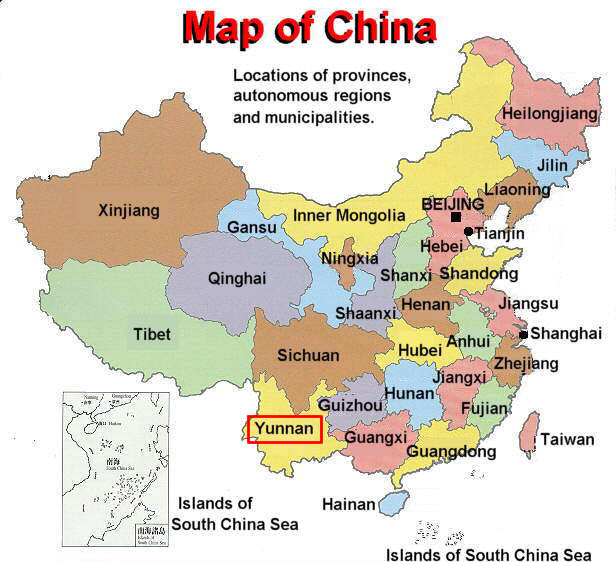
In the surroundings of the city of Pu Erh a refined tea plant is cultivated, which belongs to the large-leaved variation
Camellia sinensis assamica.
The freshly plucked leaves are transported to Pu Erh where they are centrally processed into black tea. This is how the tea gets the name Pu Erh tea.
The tea leaves are first roasted in the same way as green tea so that most of the enzymes are deactivated. After rolling and drying, the tea is stored in stacks under high humidity.
Since some of the enzymes are still active, a slow fermentation process takes place, which is called post-fermentation.
For lovers of this type of tea, this gives Pu Erh its special aroma, for others it is just the smell of rotten tea.
Pu Erh is offered both as loose tea and as pressed tea bricks (see below).
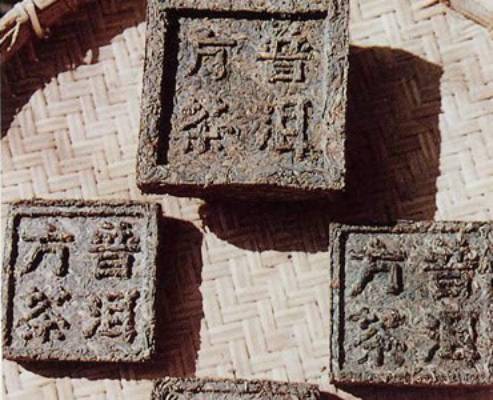 The characters "Pu Er Fang Cha" (Pu Erh brick tea) are pressed on the tea tiles.
The characters "Pu Er Fang Cha" (Pu Erh brick tea) are pressed on the tea tiles.
Pu Erh was much sought after by the equestrian peoples because of its long durability. Even today it is mainly consumed by Tibetans and Mongolians.
Neudings it is also known in the West for its supposedly slimming effect.
However, the whole theory about this effect of Pu Erh tea is based on a few not very meaningful specialist publications.
The whole thing is probably another marketing flop.

